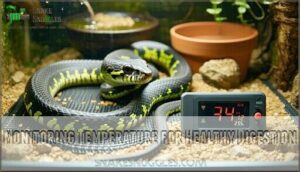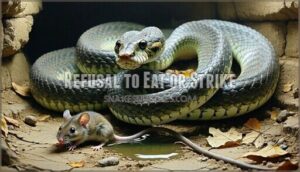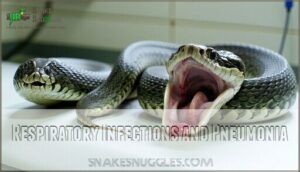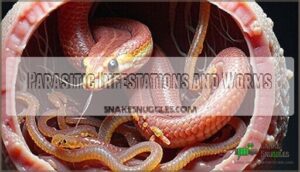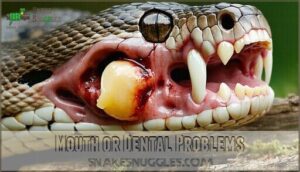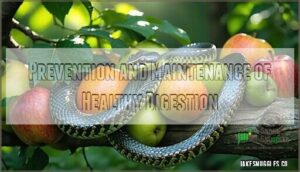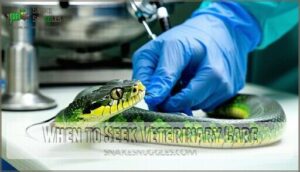This site is supported by our readers. We may earn a commission, at no cost to you, if you purchase through links.
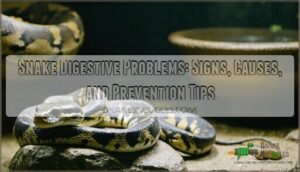
Common causes include impactions from eating substrate, intestinal parasites, or improper temperatures in their enclosure. Stress, molting, or even seasonal changes might also play a role.
Watch for signs like refusal to eat, visible ribs, or lethargy. Keep their habitat clean, maintain proper temperature and humidity, and offer appropriately sized prey to support digestion.
If you notice persistent issues or severe symptoms, consult a reptile vet right away. A little prevention goes a long way—healthy digestion keeps your snake slithering happily. Ready to learn more? Keep reading!
Table Of Contents
- Common Digestive Issues in Snakes
- Natural Causes of Appetite Loss
- Environmental Factors Affecting Appetite
- Monitoring Temperature for Healthy Digestion
- Signs of Digestive Problems in Snakes
- Potential Health Issues Affecting Digestion
- Strategies to Encourage Healthy Digestion
- Treating Digestive Issues in Snakes
- Prevention and Maintenance of Healthy Digestion
- When to Seek Veterinary Care
- Frequently Asked Questions (FAQs)
- What to do if snake is struggling to eat?
- What does a constipated snake look like?
- What are the symptoms of IBD in snakes?
- What are the symptoms of stomatitis in snakes?
- What is a snake’s digestive system?
- What are the symptoms of gastrointestinal issues?
- What happens if a snake eats infrequently?
- Why is my snake poop so bad?
- What are the symptoms of impaction in snakes?
- How to help a snake that’s constipated?
- Conclusion
Common Digestive Issues in Snakes
Snakes can experience a variety of common digestive problems, including regurgitation, constipation, and impaction, often caused by improper feeding or environmental conditions.
Regurgitation, constipation, and impaction are common snake issues, often linked to poor feeding habits or unsuitable living conditions.
Recognizing signs like appetite loss, bloating, or changes in stool can help you address issues early and protect your snake’s health.
Mouth Rot and Its Causes
Mouth rot, or snake stomatitis, arises from bacterial infections like Pseudomonas or E. coli, often caused by trauma or immune suppression.
Mouth rot stems from bacteria like Pseudomonas or E. coli, often linked to trauma or weakened immunity in snakes.
Fungal involvement and poor preventative husbandry, such as unclean enclosures or low temperatures, worsen the risk.
Signs include swollen gums, refusal to eat, and bloody mucus. If untreated, it can severely impact digestion and health.
Immediate veterinary care is essential, often requiring snake antibiotics and medication. Prevent issues with proper hygiene, suitable temperatures, and injury-free enclosures to ensure proper hygiene.
Respiratory Infections and Digestion
While mouth rot affects the oral cavity, respiratory infections strike deeper, impacting your snake’s entire digestive system.
When your snake develops pneumonia or other respiratory issues, their metabolic rate slows dramatically, leading to appetite reduction and digestive problems.
Watch for these snake health warning signs:
- Bubbling mucus from mouth or nostrils
- Open-mouth breathing or wheezing sounds
- Lethargy combined with food refusal
These symptoms indicate immune suppression that affects both respiratory and digestive functions.
The connection is clear – a snake fighting to breathe can’t properly digest food.
Treatment overlap often occurs, with medications addressing both systems simultaneously.
Don’t wait for symptoms to worsen.
Respiratory infections require prompt veterinary care, as snake pneumonia can quickly become life-threatening when combined with digestive issues.
It is crucial to address digestive problems and respiratory issues promptly to ensure the snake’s health and survival, and to prevent the condition from becoming life-threatening.
Intestinal Parasites and Worms
While respiratory issues can impact your snake’s overall health, internal invaders can directly attack their digestive system.
Intestinal parasites and worms are common but serious threats to your snake’s wellbeing. These unwelcome hitchhikers—like roundworms, hookworms, and single-celled microorganisms—can cause significant problems if left untreated.
Watch for these warning signs:
Visible worms
Prevention is your best defense. Keep enclosures clean, schedule regular fecal exams, and don’t forget the zoonotic potential—some parasites can affect humans too.
If you suspect parasitic infestations, don’t wait. Professional deworming from a reptile vet is vital, as proper worm identification guarantees effective treatment. With proper preventative measures, you’ll help your slithery friend stay healthy.
Obstructions and Impactions
Five major causes contribute to snake impaction and obstructions: ingesting substrate, consuming oversized prey, dehydration, temperature issues, and structural abnormalities.
Symptoms include a distended abdomen, lack of defecation, and lethargy. Diagnosis often requires veterinary examination.
For treatment, mild cases may respond to warm water soaks, while severe blockages need surgery. Prevention is your best strategy—maintain proper hydration, monitor feeding, and choose safe substrates.
Regular checks for abnormal lumps will help you catch intestinal blockages early, which is crucial for effective prevention.
Natural Causes of Appetite Loss
You’ll notice your snake’s appetite naturally decreases during specific life phases like molting, seasonal changes, or growth periods.
These temporary appetite shifts are normal biological responses and don’t always indicate a health problem, though you should still monitor them to distinguish between natural fasting and potential illness.
Molting and Seasonal Changes
Many snakes naturally lose their appetite during molting cycles, which is perfectly normal behavior.
When your pet enters the shedding process, their interest in food typically decreases as they focus energy on developing new skin.
This molting frequency varies by species, age, and seasonal changes.
Environmental adjustments and temperature influence play significant roles in this natural cycle.
Watch for cloudy eyes and dull scales as signs that shedding is approaching.
Most snakes resume normal feeding once molting completes.
If your snake refuses food for extended periods beyond molting or shows unusual snake behavior, consult a veterinarian for proper guidance.
Hibernation and Cooler Weather
During cooler weather, your snake’s appetite naturally decreases as part of brumation – their version of hibernation. This seasonal adjustment is perfectly normal when temperatures drop, causing their metabolism and digestion to slow dramatically.
Your snake’s brumation effects include:
- Reduced food interest for weeks or even months
- Slower digestion of any meals consumed
- Decreased activity and movement
- Lower water consumption
Adult snakes might refuse food for 4-8 weeks during snake hibernation periods, while still remaining healthy. Don’t force feeding during this time – it can stress your pet and cause digestive complications.
Instead, maintain appropriate enclosure temperatures and monitor weight to confirm the appetite reduction is indeed seasonal rather than illness-related. Once warmer conditions return, normal feeding behaviors typically resume.
Growth and Development in Young Snakes
While adult snakes may slow down during colder months, young snakes follow their own unique development path.
Hatchlings experience rapid growth spurts that directly affect their feeding frequency and digestion. You’ll notice your young snake may eat more often than adults to fuel development.
During growth stages, nutrient needs increase dramatically. As they mature, adjust prey size accordingly and monitor their brumation impact, which can differ from adults.
Snake development requires patience and careful observation.
Environmental Factors Affecting Appetite
Your snake’s environment directly affects its appetite and digestion, so you’ll need to maintain proper temperature, humidity, and a comfortable habitat to keep your pet eating well.
Simple changes to enclosure setup, lighting cycles, and water quality can make a big difference in preventing digestive problems before they start, which is crucial for maintaining a healthy and comfortable habitat.
Substrate and Enclosure Setup
Your snake’s enclosure setup serves as both home and health foundation, directly influencing its appetite and digestion.
Proper substrate choice prevents impaction while supporting natural behaviors.
- Snake enclosure size should match your pet’s length—generally allowing them to stretch fully with some room to explore.
- Hiding spots reduce stress, promoting regular feeding patterns and healthy digestion.
- Thermal gradients (75-85°F for most species) support proper metabolism and digestive processes.
Maintain cleanliness levels by spot-cleaning daily and replacing substrate monthly.
Different snake substrate types work better for different species—burrowing snakes need 3-4 inches depth, while arboreal species need less.
Consider appropriate habitat dimensions for your snake’s overall health.
Remember: comfortable snakes eat better!
Daylight-Darkness Cycle and Lighting
Your snake’s health depends on proper daylight-darkness cycles, often called photoperiods.
Lighting affects digestion through their natural circadian rhythm.
- Provide 12-14 hours of light daily to mimic natural seasonal lighting
- Use low-intensity bulbs that won’t stress your reptile friend
- Consider UVB lighting to support vitamin D3 synthesis and metabolism
- Implement gradual shifts between light and dark periods
Just like humans need day-night patterns for proper function, your snake’s digestive system relies on consistent lighting cues.
You can purchase a reptile daylight bulb to help maintain these cycles.
Without them, appetite and digestion often suffer.
Temperature and Humidity Imbalance
Balancing temperature and humidity creates the perfect "Goldilocks zone" for your snake’s digestive health.
Temperature swings dramatically affect digestion, while improper humidity levels can trigger respiratory issues.
You can find a snake’s ideal environment online.
| Factor | Impact | Solution |
|---|---|---|
| Temperature regulation | Slows/speeds metabolism | Maintain stable gradients |
| Ideal humidity levels | Prevents skin problems | Use hygrometer to monitor |
| Unstable heat | Causes digestive stress | Install reliable thermostats |
Monitor your enclosure with quality thermometers and hygrometers, adjusting heat sources and misting routines to create the ideal environment where snake digestive problems become a thing of the past, ensuring a stable and healthy condition for your pet, with proper temperature regulation and humidity levels.
Food and Water Quality
Your snake’s health hinges on what goes into its body. Quality food and clean water directly impact their digestion and overall wellness.
- Water sources should be changed daily to prevent bacterial growth and contamination risks
- Properly stored prey items maintain nutritional value and support nutrient absorption
- Occasional supplementation addresses specific dietary needs that single-prey diets might miss
Don’t underestimate how water quality affects hydration and digestion. Fresh, thawed prey items offer better nutrition than those stored too long. Remember, your snake’s digestive system works best when provided with high-quality food and pristine water sources.
Monitoring Temperature for Healthy Digestion
You’ll need to maintain proper temperatures in your snake’s enclosure to guarantee food moves smoothly through their digestive system.
When temperatures drop too low, your snake’s metabolism slows down, which can lead to undigested food and serious health problems.
Ideal Temperature Ranges for Snakes
Maintaining proper temperature ranges is essential for your snake’s digestive health.
Different species have specific needs for ideal metabolism and digestion.
| Species | Basking Spot | Cool Side | Night Temperature |
|---|---|---|---|
| Ball Python | 88-92°F | 78-80°F | 75-78°F |
| Corn Snake | 85-88°F | 75-80°F | 70-75°F |
| Boa Constrictor | 90-95°F | 80-85°F | 78-82°F |
| King Snake | 85-90°F | 75-80°F | 70-75°F |
| Garter Snake | 80-85°F | 70-75°F | 65-70°F |
Proper thermal gradients allow your snake to regulate its body temperature naturally, ensuring efficient digestion and preventing health issues.
Avoiding Temperature Extremes
For both digestion and comfort, your snake needs protection against temperature extremes.
Create thermal gradients with warm basking spots (85-95°F) and cooler retreat areas (75-80°F).
Night temperatures should drop slightly but never below 70°F.
Proper temperature regulation prevents digestive problems like impaction and regurgitation.
Multiple heat sources distribute warmth evenly across the enclosure, supporting your snake’s environmental temperature needs and metabolic functions.
Using Thermometers and Heating Pads
Beyond avoiding extremes, proper monitoring tools are essential for your snake’s digestive health.
You’ll need reliable equipment to maintain ideal temperatures:
- Digital thermometers provide accurate readings in multiple tank locations, eliminating guesswork about temperature gradients
- Heating pad placement should cover only 1/3 of the enclosure to create thermal gradients
- Thermostat controllers prevent reptile burns by automatically regulating heating pad temperatures
Never rely on touch alone—what feels warm to you might be dangerously hot for your scaly friend.
Signs of Digestive Problems in Snakes
You’ll notice clear warning signs when your snake has digestive problems, including regurgitation, unusual bloating, or sudden weight loss.
Early detection of these symptoms allows for prompt treatment, helping your snake recover faster and preventing more serious health complications.
Refusal to Eat or Strike
While proper temperatures help digestion, a snake’s refusal to eat signals deeper issues.
Your snake’s feeding strike might indicate stress, dehydration, or underlying illnesses.
Snake anorexia often stems from poor husbandry or brumation signs.
Pay attention if your pet strikes but won’t consume prey—this hunger strike isn’t normal.
Try offering prey variety and different feeding techniques to stimulate appetite loss.
Remember, prolonged feeding refusal requires veterinary care for stress reduction and to restore your snake’s appetite.
Weight Loss and Visible Rib Bones
Weight loss in snakes often reveals itself through visible rib bones, a serious sign of digestive problems.
When your snake’s body becomes noticeably thinner, consider these warning signs:
- Sunken sides between ribs indicate muscle atrophy
- Prominent spine suggests ongoing nutritional deficiencies
- Dull, loose skin points to dehydration signs
- Sharp-edged vertebrae require immediate veterinary assessment
- Progressive thinning signals underlying causes need attention
Don’t wait until extreme weight loss occurs – early intervention prevents serious snake health complications.
It is crucial to address these issues promptly to ensure the well-being of your snake, as visible rib bones can be a significant indicator of underlying health problems, and early intervention is key to preventing further complications.
Decreased Activity and Shedding Abnormalities
While weight loss shows on the outside, a snake’s behavior tells an equally important story.
When your snake shows decreased activity and shedding abnormalities, these often indicate digestive problems.
| Sign | What It Means | Action Needed |
|---|---|---|
| Lethargy | Possible digestive slowdown | Check temperatures |
| Retained shed | Dehydration | Increase humidity |
| Sluggish behavior | Nutritional deficiency | Review diet |
| Incomplete sheds | Systemic illness | Veterinary check |
| Abnormal activity | Digestive obstruction | Immediate vet care |
Potential Health Issues Affecting Digestion
Your snake’s digestive health can be affected by several medical conditions including respiratory infections, parasites, mouth problems, and intestinal blockages.
You’ll need to monitor these potential issues closely, as early detection is key to successful treatment and preventing serious complications in your pet snake, which is crucial for its overall health and successful treatment.
Respiratory Infections and Pneumonia
Respiratory infections in snakes often manifest as wheezing and open-mouth breathing, seriously affecting their digestion and appetite.
These respiratory symptoms typically stem from bacterial causes, though fungi and viruses can also trigger pneumonia in your reptile companion.
If you notice mucus around the nostrils or labored breathing, don’t wait—these infection symptoms require prompt veterinary attention.
Treatment options usually include antibiotics and environmental adjustments.
To prevent these secondary infections, maintain proper humidity levels, clean enclosures regularly, and guarantee stable temperatures. Remember, respiratory health directly impacts your snake’s digestive system and overall wellbeing.
Parasitic Infestations and Worms
While respiratory issues can hamper breathing, parasites attack from within, directly impacting your snake’s digestion. Intestinal parasites like roundworms often cause noticeable weight loss and weakness in your reptilian friend.
- Mite infestations can stress your snake, leading to decreased appetite and digestion problems
- Protozoan disruption affects nutrient absorption, causing malnutrition despite regular feeding
- Worm infestations may be visible in droppings or regurgitated material
Regular veterinary check-ups help detect parasite burden before serious complications develop, and Yearly fecal screenings are essential for early detection of these issues, ultimately affecting your snake’s overall health and well-being, including potential malnutrition.
Mouth or Dental Problems
Oral health plays a critical role in your snake’s digestion.
Mouth rot (stomatitis), dental abscesses, or trauma can prevent proper feeding. Watch for excessive saliva, swelling, or a cheesy discharge—all warning signs of infection.
Regular inspection of your snake’s mouth can catch issues early, preventing serious digestive problems.
If you notice your pet refusing food or struggling to eat, consult a reptile veterinarian immediately to address potential issues like mouth rot.
Digestive Disorders and Impactions
While mouth problems can hinder eating, digestive disorders can create even more serious complications for your snake.
Impactions and gut obstructions often result from ingesting substrate or prey that’s too large.
Watch for these snake digestive problems:
- Regurgitation of partially digested food
- Visible swelling or hard areas in the abdomen
- Lack of defecation for extended periods
- Straining during attempts to pass waste
When you notice these signs, don’t wait—constipation relief and treatment for potential prolapse require prompt veterinary attention to address serious complications.
Strategies to Encourage Healthy Digestion
You can improve your snake’s digestion by maintaining proper temperatures and creating a low-stress environment with appropriate hiding spots.
You’ll also need to establish consistent feeding routines that match your snake’s species requirements, as proper prey size and handling practices directly impact digestive health.
Providing Proper Enclosure Setup
Your snake’s health starts with its home. A proper enclosure setup directly impacts digestion and overall wellness. Choose a substrate that won’t cause impaction if accidentally ingested—coconut fiber or reptile carpet works well for most species.
Install proper hiding spots at both warm and cool ends to create security. Maintain appropriate temperature gradients (75-95°F depending on species) which are essential for proper digestion.
Ensure the enclosure size allows movement without stress—too small can disrupt eating patterns. Provide fresh water access daily and position heat sources to create natural thermal gradients your snake can navigate, promoting overall wellness.
Creating a Stress-Free Environment
Creating a stress-free environment is essential for your snake’s digestive health. Reduce stressors to prevent digestive issues and promote natural behavior.
- Position hiding spots strategically throughout the enclosure for security
- Minimize handling, particularly before and after feeding
- Maintain consistent schedules for feeding and enclosure maintenance
A secure habitat with proper enrichment helps your snake feel safe, directly improving digestion and overall wellbeing. Consider native vegetation for added security.
Offering Different Food Options
One simple way to prevent snake feeding problems is offering prey variety.
Mix live, frozen-thawed, and commercial options to guarantee complete nutrition.
Feed smaller items more frequently for easier digestion – an adult mouse weekly works better than a large rat.
Consider alternative prey like chicks or gerbils that match your snake’s natural diet.
Sometimes scenting food with different aromas can stimulate appetite when food quality matters for digestive health.
Consulting a Veterinarian
If your snake shows digestive trouble, reach out to a reptile vet right away.
Veterinary consultation offers:
- Expert diagnosis through specialized knowledge of snake health issues
- Treatment options specifically designed for your snake’s condition
- Emergency intervention when severe symptoms appear
Don’t wait until small problems grow serious.
Regular snake health visits provide preventative care that catches issues early, saving both money and potential heartache.
Treating Digestive Issues in Snakes
You’ll need to act quickly when your snake shows signs of digestive problems, as prompt treatment can prevent serious complications.
From antibiotics and gentle fluid therapy to surgical options for severe blockages, your veterinarian can offer several effective treatments suited to your snake’s specific condition.
Antibiotics and Medication
When selecting antibiotics for your snake’s digestive issues, proper dosage calculation is essential to prevent resistance development.
Extended-spectrum penicillins target gram-negative bacteria, while fluoroquinolones treat internal infections.
Monitor for medication side-effects and consider probiotic support alongside treatment.
Different snake antibiotics require specific administration methods—mix oral medications with food or use topical options for external issues.
Always consult your veterinarian before starting any medication therapy.
Fluid Therapy and Force Feeding
While antibiotics fight infections, getting fluids into your dehydrated snake is equally essential.
Fluid therapy restores hydration through subcutaneous or oral administration, but carries risks if done incorrectly.
When necessary, force-feeding techniques provide nutritional support for severely ill reptiles.
Always seek veterinary oversight before attempting either procedure – proper technique prevents aspiration and stress.
Your snake’s recovery depends on balanced hydration and nutrition during digestive issues, making professional guidance non-negotiable.
Surgical Intervention for Obstructions
Sometimes, a snake surgical intervention is required for obstructions, especially when digestion-blocking issues don’t improve with basic care.
Surgical removal focuses on clearing bowel obstruction or foreign bodies through precise incisions, avoiding further harm.
While anesthesia risks and recovery timelines matter, vet-supervised post-op care boosts success.
Obstruction severity dictates urgency, so act quickly—prevention‘s always cheaper than surgery.
Prevention and Maintenance of Healthy Digestion
You can keep your snake’s digestion on track by maintaining proper temperatures, humidity, and enclosure hygiene.
Providing a balanced diet and scheduling regular check-ups with a veterinarian will help prevent common digestive problems, which is crucial for maintaining overall health and preventing issues related to digestion.
Regular Veterinary Check-Ups
Regular vet checkups are the best way to keep your snake healthy and catch problems early.
A reptile vet can offer expert advice and guarantee your snake thrives.
Make sure to schedule regular health checks for:
- Parasite screening: Spot infections before they affect digestion.
- Preventative care: Identify health risks with early detection.
- Health records: Build a clear medical history for accurate future diagnosis.
Regular visits mean fewer surprises and a healthier pet.
Proper Hygiene and Enclosure Cleaning
Keeping a spotless enclosure is essential for snake hygiene and digestion.
Start with daily waste removal to avoid bacteria buildup and mold. Change water every two days for fresh hydration.
Disinfecting enclosures weekly with reptile-safe products keeps harmful germs at bay. Use the right substrate and replace it as needed, depending on your snake’s species.
Enclosure cleaning isn’t just about appearances—it’s about preventing infections and giving your snake a stress-free home. A clean enclosure guarantees your snake stays healthy and comfortable every day, ensuring snake hygiene is maintained.
Balanced Diet and Nutrition
Providing a snake balanced diet means prioritizing prey variety, like rodents or birds, to guarantee proper reptile nutrition.
Adjust feeding frequency for their size and age. Emphasize food quality—use fresh, well-fed prey (gut loading boosts nutrient balance).
Hydration importance shouldn’t be overlooked; always offer clean water. Supplementation needs, like calcium or vitamins, help fill gaps, supporting digestion and preventing deficiencies efficiently.
Maintaining proper humidity levels is also critical for healthy digestion.
Monitoring Temperature and Humidity
Maintaining the right temperature gradients and humidity levels is like creating the perfect mini-climate for your snake.
Use heating mats for warm basking spots and guarantee cooler areas with proper thermometer placement.
Regularly check humidity using a calibrated hygrometer, as improper snake humidity can lead to respiratory or digestive issues.
Avoid dangerous temperature drops below 60°F (15.5°C) or excessive heat above 95°F (32°C).
Seasonal adjustments are key—consider slight temperature tweaks to mimic natural shifts.
Balanced thermal gradients will keep digestion smooth and your snake healthy.
When to Seek Veterinary Care
If your snake shows ongoing digestive problems or sudden, severe symptoms like vomiting or bloating, it’s time to contact a veterinarian.
Early treatment can prevent serious complications and guarantee your pet stays healthy.
Emergency Situations and Symptoms
In the event of snake emergencies, knowing the red flags can save a life.
Watch for these urgent symptoms:
- Immediate regurgitation or frequent vomiting.
- Severe bloating signaling digestive blockage.
- Visible trauma like cuts or swelling.
- Prolapsed tissue from the cloaca.
If you spot any of these, act fast.
Visit a vet immediately to prevent rapid deterioration.
Chronic Digestive Issues and Weight Loss
Chronic snake digestive issues, like malabsorption syndromes or enzyme deficiencies, can lead to worrying weight loss.
If your snake struggles with persistent anorexia or shows signs of cachexia effects, it’s time to act.
Watch for these red flags:
- Unexplained weight loss, even when eating.
- Lethargy or lack of activity.
- Irregular stools — diarrhea or undigested food.
- Symptoms of dehydration, like sunken eyes or wrinkled skin.
Persistent anorexia, a disrupted gut microbiome, or long-term snake digestive disorders may be culprits.
Ensuring stable humidity levels can prevent many digestive issues.
Malnutrition and chronic issues can harm essential organs.
Schedule a vet appointment to address potential snake digestive problems promptly.
Early care prevents complications.
Changes in Behavior or Appetite
Changes in snake behavior or appetite, like feeding refusal or unusual activity, often hint at stress, illness, or digestive trouble.
Watch for lethargy signs, weight changes, or an activity decrease.
Increased hiding, aggression, or inconsistent eating patterns can signal issues with snake digestion.
If your snake shows these symptoms, it’s time to consult a vet to rule out regurgitation risks or health concerns.
Frequently Asked Questions (FAQs)
What to do if snake is struggling to eat?
Check your snake’s enclosure setup—ensure proper temperatures, humidity, and hiding spots.
Offer appropriately sized prey and avoid handling before or after feeding.
If problems persist, consult a reptile vet to rule out health issues, and remember to consult a professional for accurate diagnosis.
What does a constipated snake look like?
It’s funny how subtle signs can be so telling.
A constipated snake might appear bloated, struggle to pass stool, or seem lethargic.
You might also notice straining or swelling near its lower belly.
What are the symptoms of IBD in snakes?
IBD in snakes shows up as regurgitation, weight loss, tremors, and poor muscle control.
You might notice them refusing food, acting lethargic, or struggling to move normally.
It’s serious, so consult a vet immediately.
What are the symptoms of stomatitis in snakes?
Stomatitis in snakes, often called mouth rot, shows as swollen gums, redness, pus, or dead tissue in the mouth.
You might notice difficulty eating, excessive drooling, or a foul smell coming from their mouth.
What is a snake’s digestive system?
The snake’s digestive system works like a slow, efficient conveyor belt.
Food travels from the mouth to the stomach, then the intestines, where nutrients are absorbed, before waste exits through the cloaca.
What are the symptoms of gastrointestinal issues?
Loss of appetite, bloating, regurgitation, constipation, and changes in stool quality often signal digestive trouble.
Watch for straining during bowel movements, swollen bellies, dehydration, or lethargy—these could mean urgent attention is needed.
What happens if a snake eats infrequently?
If eating infrequently, a snake’s metabolism slows, making digestion more efficient but risking malnutrition over time.
Long gaps between meals can stress its body, weaken immunity, and signal environmental or health issues needing attention, which may indicate a need for closer monitoring of the snake’s overall health.
Why is my snake poop so bad?
Bad-smelling snake poop usually means digestion issues, parasites, or poor diet.
Think of it as a red flag.
Check for irregular stool appearance, review feeding practices, and make certain clean, well-regulated enclosure conditions to avoid trouble, considering it a signal for potential digestion issues.
What are the symptoms of impaction in snakes?
Signs of impaction include a swollen belly, lack of defecation, visible straining, and lethargy.
You might also notice your snake refusing food or appearing uncomfortable when moving.
Prompt veterinary care is essential for treatment.
How to help a snake that’s constipated?
Think of your snake’s belly like a traffic jam—warmth and hydration clear the way.
Raise enclosure temperatures slightly, provide a shallow soak in lukewarm water, and make certain proper humidity to help ease constipation, considering constipation as a key issue to address.
Conclusion
Picture your snake gliding smoothly through its enclosure, a sign of good health and digestion.
To prevent snake digestive problems, focus on maintaining proper temperatures, offering clean water, and feeding appropriately sized prey.
Keep their habitat clean and stress-free, and watch for signs like appetite loss or unusual behavior.
Regular vet check-ups can catch issues early, and a little effort in prevention guarantees your snake stays healthy, active, and thriving for years to come.



